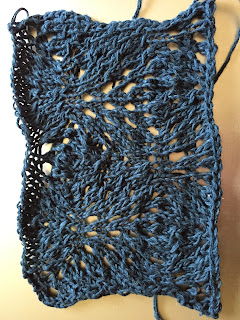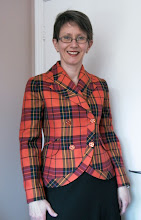 |
| And look - I had the perfect buttons in stash! |
I started knitting a cardigan in
July of 2014 and I just finished it. Holy cow it took me a long time! In between starting and finishing, I went to work just about every day, a place where knitting is frowned upon. I sewed, an activity the doing of which is incompatible with also knitting at the same time. I also did a lot of curling, during which it is impossible to knit. Although I did a bit of traveling and they let knitting on planes and trains, I am pretty sure it's illegal to knit while driving. But the real reason it took me so long? Knitting acres of stockinette stitch is truly rather boring.
Last week, I'd had enough. I was within spitting distance of finishing the body (this cardigan is knit from the neckline on down to the hem). But the sleeves! Sleeves are not little tiny things; they're almost as big as the back of a sweater. And there are two of them! All stockinette; OMG I wasn't going to finish this thing until 2016.
In desperation I grabbed the life line offered by my knitting machine. I was delighted to find out that the Passap DM80 would handle my sport weight yarn (like a champ, really) and so I held my breath and carefully and with much cursing managed to transfer the live sleeve stitches from my project to the slippery little latch hook needles of my Passap, which can knit a tube, and very carefully and with much cursing knit two sleeves in two evenings.
They are not perfect. No sirree, not at all. The yarn (a strand of kind of dull purple alpaca held together with a strand of lively purple cotton/cashmere yarn) formed subtle stripes (which it didn't do when knit by hand). I managed to slip (not drop) a couple of stitches and didn't notice until it was too late to fix them. The machine left some loops of excess yarn when changing direction (4 times per sleeve, if you want to know). The gauge is not 100% spot on my hand knitting gauge. However, these defects are as fixed as I could make them, or are pretty subtle. The sleeves are good enough. And this puppy is finished.
Just in time for the warmth of summer, during which The Sewing Lawyer will certainly not be wearing an alpaca cardigan with long sleeves. However, 4 months in the magic closet will do its work, and in October or so, this thing actually will be perfect.
Do you know what knitting machines are
really good at? You guessed it: stockinette. I have a lot of this cotton/cashmere yarn left. I could make a smashing light weight top to wear under this cardigan, when the weather cools off.
More details?
OK, here's the back. I like the bit of ribbing; it was so interesting to knit (not really, but it was more interesting than stockinette).
Knitting is so organic, and the construction of this sweater was super interesting (or would have been if it hadn't been all stockinette). But you know? You end up with a really floppy product. In particular, a top down and seamless sweater has zero structure in the shoulder and armscye areas. And knitting stretches, and it droops. The rate at which you increase, in this pattern, dictates the width of your sleeve caps and of your sweater body. You can't separate for the sleeves whenever you want. If your row gauge isn't perfect you can get an armscye that's not the right length. Mine was too long, and it would only stretch more with wear. This happened.

In the photo at left, one armscye was fixed and the other wasn't. No prizes for guessing which one.
 |
Two armscye "seams" - the one
on the left is fixed |
The fix is to get a crochet hook and crochet a chain, picking up the back of the knitted stitches along the armscye line (i.e. the point where I was increasing). This can draw the knitted fabric up, easing it invisibly so the line is shorter, and it also doesn't stretch so it provides stability.
The armscye is still a bit too low when coupled with the rather slim sleeves, but I will be able to live with it and this defect might even disappear in the magic closet.
 Look! It fits me in the shoulders!
Look! It fits me in the shoulders!













